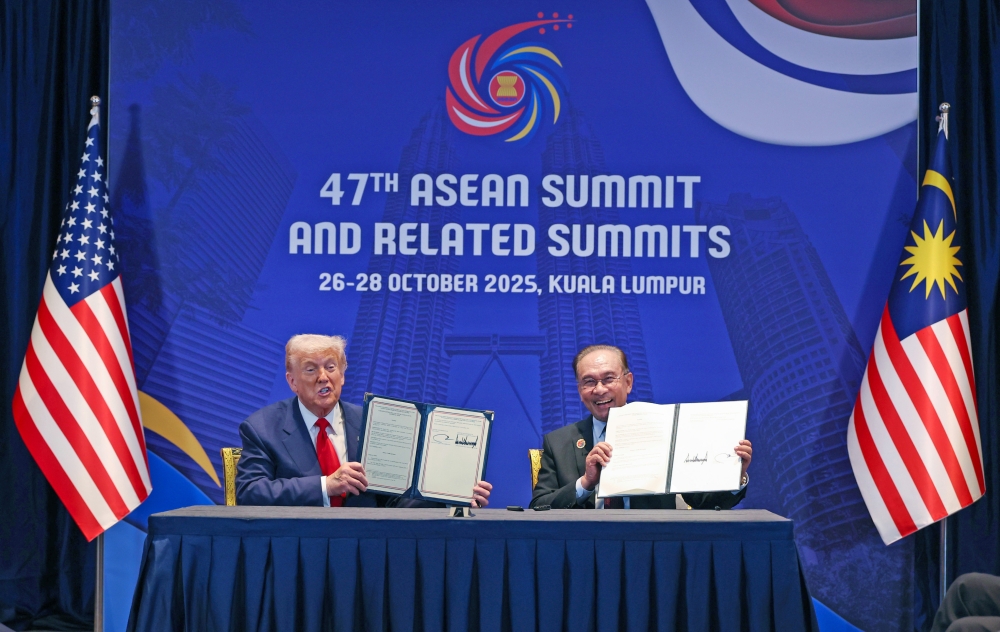The strange paradox of Chinese economic decline
Productivity has underperformed the US and other advanced economies since Xi Jinping took power

China’s share of the global economy is shrinking for the fourth year in a row. Few are aware of this astonishing development, and even fewer predicted it.
Chinese GDP equaled three-quarters of American GDP in 2021: it has fallen to just two-thirds today, when measured at market exchange rates, the relevant metric for the projection of world power across the full strategic spectrum.
“The era in which China’s share of global output was surging has ended,” says Mark Williams, head of Asia at Capital Economics. The yuan may rise again, but woe betide Chinese deflation if it does.
Productivity growth has collapsed and has even been negative by some measures. It has underperformed the US and other advanced economies since Xi Jinping took power in 2012 and turned away from China’s Great Reopening.
“Economic growth is being powered almost entirely by investment, despite diminishing returns and escalating debt,” says Williams.
The malaise has spread even to Chinese manufacturing, long thought immune. “There is mounting evidence that industrial policy is itself partly to blame,” he says.
Capital Economics says the trend rate of output growth is likely to drop to 2pc this decade. By then the demographic crisis will be deepening. China’s workforce will be 8pc smaller in 2040.
China will not overtake the US to become the world economic hegemon by 2050 on current trend lines.The gap may instead widen slightly, assuming that America overcomes its Maga fever in time to avert economic suicide.
Yet at the same time, China is running away with the electrotech revolution. China owns the global solar industry and it controls every stage of the supply chain for electric vehicles – from mineral mines to battery technology.
DeepSeek AI is nipping at the heels of US rivals in artificial intelligence, seemingly able to do so at a fraction of the energy use and compute power.
Note, however, that DeepSeek is not a validation on Communist Party strategy. It came out of a hedge fund building AI models for algorithmic trading.
“It did not need, nor did it ask for, any external help and leapfrogged many which were already queuing at the industrial policy counter,” said George Magnus from Oxford University’s China Centre.
Many of China’s tech stars – Huawei, JD.com, Tencent and Alibaba – have their origins in Deng Xiaoping’s era of economic liberalism, when the entrepreneurial dynamism of the Chinese people was allowed to flourish.
“These household names are the children of another era,” he said.
Nevertheless, Xi has launched multiple Manhattan Projects, aiming to leapfrog the West in nuclear fusion, quantum computing, robotics, and across the gamut of the 4th Industrial Revolution. Australia’s Strategic Policy Institute says China leads research in 37 of 44 critical technologies that it tracks.
China has suddenly emerged as a world player in advanced pharma, developing three times as many novel drugs as the EU. Akeso’s new cancer treatment has upstaged Merck’s Keytruda.
China lags in semiconductors but its largest foundry SMIC has cracked 7nm (nanometer) chips, circumventing the US-Dutch embargo on extreme ultraviolet lithography machines by using older kit. Beijing is closing the chip gap.
The paradox is how these two opposed faces of China can coexist.
The answer is that one is a function of the other. Beijing has funnelled vast sums into a top-down industrial policy that promotes ideological and geostrategic objectives, deforming the rest of the economy in all kinds of ways.
The Soviet Union took the same contradiction to further extremes. It could put Yuri Gagarin into orbit on Vostok 1 but could not build a good fridge or stock a grocery shelf.
Japan’s two lost decades are a template of sorts. A spate of books in the late 1980s claimed that Japan’s planning mandarins had found the secret of success, consigning the US to irreversible decline. Those books are hilarious to read today.
“We have seen this story before. Japan was at the technological cutting edge across a range of sectors in the 1980s. Japanese industrial policy was widely believed to have been an important catalyst,“ said Mark Williams.
Instead, the planning regime proved to be a curse. Failing companies were kept alive for political reasons or to protect jobs, blocking the process of Schumpeterian clearance. Subsidies become corrosive.
Japan continued to score technology hits after the economy hit a brick wall. It had half the world’s robots in the mid-1990s. It launched the first hybrid car. It developed lithium-ion batteries, digital cameras and 3G mobile. They did not move the needle on wider diffusion of productivity.
George Magnus argues in a new report for the Council on Geostrategy that China may be spending as much as 7 to 8pc of GDP on industrial policy, outstripping anything like it attempted in history.
That is circa $1.6tn (£1.2tn) a year. Target sectors enjoy subsidies, cheap credit and energy, tax breaks, and the prop of public procurement.
The aim of the Communist Party is to mobilise technological change to overthrow the existing global order, a concept rooted in Marxist doctrine.
The result is systemic overcapacity and deflation, which is prolonging the property bust and increasing the real burden of combined public and private debt, now 292pc of GDP.
Magnus said there are over 150 EV companies fighting bitter price wars and losing money, mostly zombie companies kept afloat longer than they should.
China has paid an exorbitant price for stars such as BYD and CATL, the car and battery giants, or to exhaust itself in conquering half the world market for steel and shipbuilding – provoking a backlash that is finally turning serious. “Technological islands of excellence are no substitute for good macroeconomic governance,” said Magnus.
China may yet recover from its lost economic decade. What is remarkable today is that a weakened China has taken the risk of weaponising its stranglehold over critical minerals, battery components, and mid-grade chips for cars – not just in retaliation against Donald Trump but against the whole democratic world.
The new measures, only partly suspended in the latest US-China truce, encompass all the materials and precursors that go into these technologies. The controls are extraterritorial and ferocious.
Scott Bessent, the US treasury secretary, is right that China “made a real mistake” by pulling the trigger on rare earths, even if his talk of replacing Chinese supply in 12 to 24 months is implausible bluster. Xi has destroyed global trust in Chinese supply chains of any kind.
It all points to a reverse Thucydides trap. Thucydides said the deep cause of the Peloponnesian War was “the growth of the power of Athens and the fear which this caused in Sparta”.
A cottage industry has arisen evoking this historical parallel to warn that the US might precipitate a war to stop the rise of China. But recent scholarship, including Sparte contre Athènes by French historian Manuel Rodrigues de Oliveira, argue more accurately that Thucydides had the matter backwards.
Sparta had been through a rough patch but was beginning to reassert it lost hegemony in the years before the war. It was an overbearing Athens that saw its brief and tenuous dominance threatened. It was Athens that provoked the war by blockading the ports of the Spartan alliance.
Perhaps the real danger today is that a declining China will exploit its short window of peak leverage to close in on Taiwan before America has fully recovered. That could go horribly wrong.
[Source: Daily Telegraph]

















































